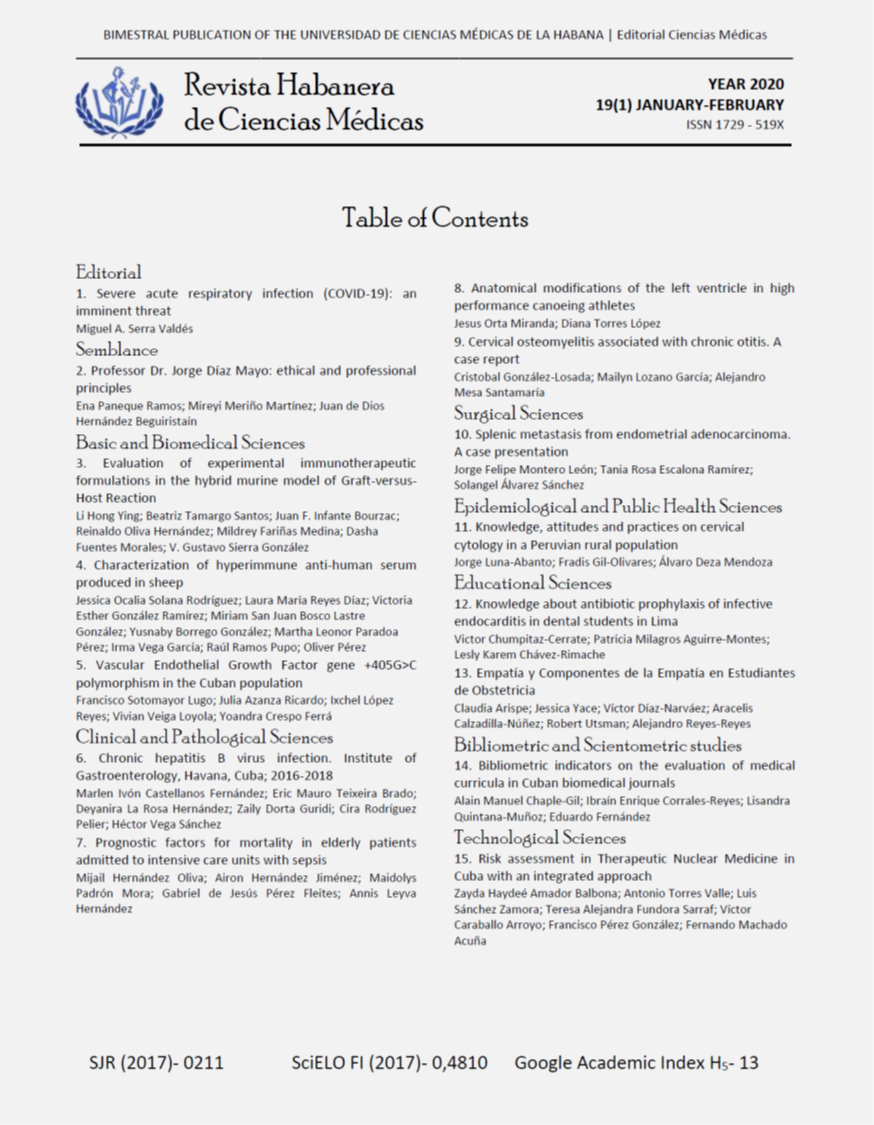Prognostic factors for mortality in elderly patients admitted to intensive care units with sepsis
Keywords:
Sepsis, prognostic factors, elderly, mortality, intensive care.Abstract
Introduction: Sepsis is defined as a life-threatening organ dysfunction caused by an unregulated host response to infection.
Objective: To identify prognostic factors for mortality in patients 65 years old or older admitted with sepsis to the Intensive Care Unit of “Aleida Fernandez Chardiet” Teaching General Hospital between 2012 and 2017.
Material and Methods: An observational analytical retrospective study was conducted. The study population was 129 elderly patients who were diagnosed with sepsis.
Results: A total of 316 patients were admitted with sepsis; 187 of them were under 65 years old and 129 were 65 years old or older. The average APACHE II scores were much higher in those patients who could not survive (161; p˂0, 01); SOFA scores were (6, 3±2,4; 95% CI 5,8-6,8; p˂0,01). The ROC curve showed an area under the curve for APACHE II which was found to be 0,834 (95% CI 0,761-0,907) and for SOFA it was 0,941 (95% CI 0,903-0,980). On the other hand, 77,6% of patients died with septic shock (OR=47,5; 95% CI 13,2-170,5; p˂0,01) and a multiple-organ dysfunction syndrome, which was observed in 67,1% of them (OR=47,8; 95% CI 9,6-189,5; p˂0,01). According to multivariate logistic regression model, the variables significantly associated to mortality were APACHE II score ≥15 points (adjusted OR 10, 7; 95% CI 2, 8-40, 4) and SOFA ≥5 points (adjusted OR 43, 9; 95% CI 2, 3-826, 8). The model calibration was adequate (X2=5,7; p=0,336).
Conclusions: The prognostic factors for mortality in elderly patients admitted with sepsis in the service were as follows: APACHE II score ≥ 15 points and SOFA score ≥5 points.Downloads
References
1. Singer M, Deutschman CS, Seymour CW, Shankar-Hari M, Annane D, Bauer M, et al. The Third International Consensus Definitions for Sepsis and Septic Shock (Sepsis-3). JAMA [internet]. 2016 [Citado 12/08/2016]; 315(8): [aprox. 10p.]. Disponible en: https://www.ncbi.nlm.nih.gov/pmc/articles/PMC4968574/
2. Rhodes A, Evans LA, Alhazzani W, Levy MM, Antonelli M, Ferrer M, et al. Surviving Sepsis Campaing: International Guidelines for Management of Sepsis and Septic Shock: 2016. Crit Care Med [Internet]. 2017[Citado 16 /11/2018]; 45(3): [aprox. 67p.]. Disponible en: https://link.springer.com/article/10.1007%2Fs00134-017-4683-6
3. Dombrovskiy VY, Martin AA, Sunderram J, Paz HL. Rapid increase in hospitalization and mortality rates for severe sepsis in the United States: A trend analysis from 1993 to 2003. Crit Care Med [Internet]. 2007[Citado 14/08/2018]; 35: [aprox. 7p.]. Disponible en: https://insights.ovid.com/pubmed?pmid=17414736
4. Martin CM, Priestap F, Fisher H, Fowler RA, Heyland DK, Keenan SP, et al. A prospective, observational registry of patients with severe sepsis: the Canadian Sepsis Treatment and Response Registry. Crit Care Med [Internet]. 2009[Citado 28/04/2018]; 37: [aprox. 8p.]. Disponible en: https://insights.ovid.com/pubmed?pmid=19050636
5. Girard TD, Opal SM, Ely EW. Insights into severe sepsis in older patients: from epidemiology to evidence-based management. Clin Infect Dis [Internet]. 2005 [Citado 24/07/2018]; 40: [aprox. 9p.]. Disponible en: https://academic.oup.com/cid/article/40/5/719/365470
6. Ministerio de Salud Pública. Dirección de registros médicos y estadísticas de salud. Anuario estadístico de salud [Internet].2017[Citado 18/06/2018];p.31. Disponible en: http://www.bvscuba.sld.cu/2017/11/20/anuarioestadistico-de-salud-de-cuba/
7. Knaus WA, Draper EA, Wagner DP, Zimmerman JE. APACHE II: a severity of classification system. Cri Care Med. 1985; 13: 818-29.
8. García de Lorenzo A. Scores pronósticos y criterios diagnósticos en el paciente crítico. 2da ed. Madrid: Ergon; 2006.
9. García Lamberechets EJ. Factores pronósticos en el paciente anciano con sepsis en urgencias [tesis]. Madrid: Universidad Complutense; 2015.
10. Palomba H, Correa TD, Silva E, Pardini A, Cesar de Assuncao MS. Comparative analysis of survival between elderly and non-elderly severe sepsis and septic shock resuscitated patients. Einstein [Internet]. 2015[Citado 13/08/2018]; 13(3): [aprox. 7p]. Disponible en: http://www.scielo.br/scielo.php?script=sci_arttext&pid=S167945082015005053313&lng=en&nrm=iso&tlng=en
11. Carvajal Guerrero J, Cayuela Domínguez A, Fernández García E, Aldabó Pallás E, Márquez Vácaro JA, Ortiz Leyba E, et al. Epidemiología y pronóstico tardío de la sepsis en ancianos. Med Intensiva [Internet]. 2014[Citado 23/08/2018]; 38(1): [aprox. 12p]. Disponible en: http://www.medintensiva.org/es/epidemiologia-pronostico-tardio-sepsis-ancianos/articulo/S0210569112003774/
12. Gastelum Dagnino JR, Olvera Guzmán CI, Navarro Adame JL, Sánchez Calzada A, Torres Aguilar O, Delgado Ayala LY, et al. Evaluación de la mortalidad y otros resultados clínicos en la población anciana mexicana con sepsis. Rev Asoc Mex Med Crit Ter Int [Internet]. 2016[Citado 20 /08/2018]; 30(3): [aprox. 4p.]. Disponible en: http://www.medigraphic.com/cgibin/new/resumen.cgi?IDARTICULO=68088
13. Grooth HJ, Geenen IL, Girbes AR, Vincent JL, Parienti JJ, Straaten HM. SOFA and mortality endpoints in randomized controlled trials: a systematic review and meta-regression analysis. Critical Care [Internet]. 2017[Citado 2/06/2018]; 21 (38): [aprox. 9p.]. Disponible en: https://ccforum.biomedcentral.com/articles/10.1186/s13054-017-1609-1
14. Lingling W, Rui Ch, Zexun M, Jiahui D, Zhaokun S, Fie X, et al. Predictive value of SOFA score combined AGI grading system in elderly patients with sepsis a retrospective analysis with 91 patients. Chin Crit Care Med [revista en la internet]. 2017[Citado 26/08/2018]; 29(2): [aprox. 10p. ]. Disponible en: https://europepmc.org/abstract/med/28625262
15. Blanco J, Muriel-Bombín A, Sagredo V, Taboada F, Gandía F, Tamayo L, et al. Incidence, organ dysfunction and mortality in severe sepsis: a Spanish multicentre study. Critical Care [Internet]. 2008[Citado 12/04/ 2016]; 12:R158 [aprox. 14p.]. Disponible en: https://ccforum.biomedcentral.com/articles/10.1186/cc7157
16. Azkárate I, Choperena G, Salas E, Sebastián R, Lara G, Elósegui I, et al. Epidemiología y factores pronósticos de la sepsis grave/shock séptico. Seis años de evolución. Med Intensiva [Internet]. 2016[Citado 25/12/ 2016]; 40 (1): [aprox. 8p.]. Disponible en: https://www.sciencedirect.com/science/article/abs/pii/S0210569115000248
17. Ignar López JM. Factores pronósticos de mortalidad en pacientes adultos mayores con ventilación mecánica invasiva Centro Médico Naval 2014-2015 [tesis]. Lima: Universidad de San Martín de Porres; 2015.



